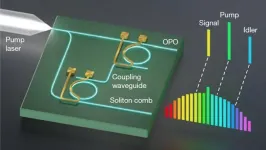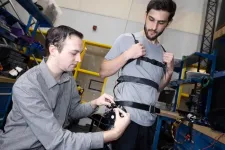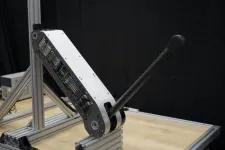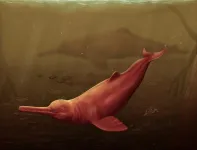(Press-News.org) In a new Nature study, Columbia Engineering researchers have built a photonic chip that is able to produce high-quality, ultra-low-noise microwave signals using only a single laser. The compact device — a chip so small, it could fit on a sharp pencil point — results in the lowest microwave noise ever observed in an integrated photonics platform.
The achievement provides a promising pathway towards small-footprint ultra-low-noise microwave generation for applications such as high-speed communication, atomic clocks, and autonomous vehicles.
The challenge
Electronic devices for global navigation, wireless communications, radar, and precision timing need stable microwave sources to serve as clocks and information carriers. A key aspect to increasing the performance of these devices is reducing the noise, or random fluctuations in phase, that is present on the microwave.
“In the past decade, a technique known as optical frequency division has resulted in the lowest noise microwave signals that have been generated to date,” said Alexander Gaeta, David M. Rickey Professor of Applied Physics and Materials Science and professor of electrical engineering at Columbia Engineering. “Typically, such a system requires multiple lasers and a relatively large volume to contain all the components.”
Optical frequency division – a method of converting a high-frequency signal to a lower frequency – is a recent innovation for generating microwaves in which the noise has been strongly suppressed. However, a large table-top-level footprint prevents such systems from being leveraged for miniaturized sensing and communication applications that demand more compact microwave sources and are broadly adopted.
“We have realized a device that is able to perform optical frequency division entirely on a chip in an area as small as 1 mm2 using only a single laser,” said Gaeta. “We demonstrate for the first time the process of optical frequency division without the need for electronics, greatly simplifying the device design.”
The approach
Gaeta’s group specializes in quantum and nonlinear photonics, or how laser light interacts with matter. Focus areas include nonlinear nanophotonics, frequency-comb generation, intense ultrafast pulse interactions, and generation and processing of quantum states of light.
In the current study, his group designed and fabricated an on-chip, all-optical device that generates a 16-GHz microwave signal with the lowest frequency noise that has ever been achieved in an integrated chip platform. The device uses two microresonators made of silicon nitride that are photonically coupled together.
A single-frequency laser pumps both microresonators. One is used to create an optical parametric oscillator, which converts the input wave into two output waves - one higher and one lower in frequency. The frequency spacing of the two new frequencies is adjusted to be in the terahertz regime. As a result of the quantum correlations of the oscillator, the noise of this frequency difference can be thousands of times less than the noise of the input laser wave.
The second microresonator is adjusted to generate an optical frequency comb with a microwave spacing. A small amount of light from the oscillator is then coupled to the comb generator, leading to synchronization of the microwave comb frequency to the terahertz oscillator that automatically results in optical frequency division.
Potential impact
The work from Gaeta’s group represents a simple, effective approach for performing optical frequency division within a small, robust, and highly portable package. The findings open the door for chip-scale devices that can generate stable, pure microwave signals comparable to those produced in laboratories that perform precision measurements.
“Eventually, this type of all-optical frequency division will lead to new designs of future telecommunication devices,” he said. “It could also improve the precision of microwave radars used for autonomous vehicles.”
The team
Gaeta, along with Yun Zhao — who was a graduate student and is now a post-doc in the Gaeta Lab — and research scientist Yoshitomo Okawachi, conceived the project’s core idea. Then, Zhao and post-doc Jae Jang designed the devices and performed the experiment.
The project was done in close collaboration with Columbia Engineering professor Michal Lipson and her group. Karl McNulty from the Lipson group fabricated the photonic chip at both Columbia and Cornell University. TheTerremoto Shared High-Performance Computing Cluster, a service provided by Columbia University Information Technology (CUIT), was used to model the noise properties of optical parametric oscillators.
END
High-quality microwave signals generated from tiny photonic chip
2024-03-20
ELSE PRESS RELEASES FROM THIS DATE:
OFC 2024 brings innovations from leading global organizations and cutting-edge tech demonstrations to California
2024-03-20
SAN DIEGO—A wave of innovation is hitting California as the Optical Fiber Communications Conference and Exhibition (OFC) gears up to showcase the latest breakthroughs in optical communications and networking.
OFC will take place at the San Diego Convention Center from 24 to 28 March 2024 drawing industry leaders, experts, academia, media, analysts and students from around the world to explore the latest in optical technology.
Innovative advancements in industrial technologies, as well as research in 800ZR, Coherent PON, Linear Pluggable Optics (LPO), multicore fiber, AI and ...
Killer whales use specialized hunting techniques to catch marine mammals in the open ocean
2024-03-20
Killer whales foraging in deep submarine canyons off the coast of California represent a distinct subpopulation that uses specialized hunting techniques to catch marine mammals, Josh McInnes at the University of British Columbia and colleagues report March 20 in the open-access journal PLOS ONE.
Killer whales (Orcinus orca) are found in oceans around the world, but they form separate populations, or ‘ecotypes’, that have their own social structure, food preferences and hunting behaviors. One ecotype, known as transient killer whales, specialize in hunting marine ...
The first Neolithic boats in the Mediterranean
2024-03-20
More than 7,000 years ago, people navigated the Mediterranean Sea using technologically sophisticated boats, according to a study published March 20, 2024 in the open-access journal PLOS ONE by Juan F. Gibaja of the Spanish National Research Council, Barcelona and colleagues.
Many of the most important civilizations in Europe originated on the shores of the Mediterranean Sea. During the Neolithic, communities clearly traveled and traded across the water, as evidenced by watercraft in the archeological record and the presence ...
Universal controller could push robotic prostheses, exoskeletons into real-world use
2024-03-20
Robotic exoskeletons designed to help humans with walking or physically demanding work have been the stuff of sci-fi lore for decades. Remember Ellen Ripley in that Power Loader in Alien? Or the crazy mobile platform George McFly wore in 2015 in Back to the Future, Part II because he threw his back out?
Researchers are working on real-life robotic assistance that could protect workers from painful injuries and help stroke patients regain their mobility. So far, they have required extensive calibration and context-specific tuning, which keeps them largely limited to research labs.
Mechanical engineers at Georgia Tech ...
Autism acceptance varies across countries – where should we target support?
2024-03-20
Societal acceptance of autism varies considerably across different countries, with lowest levels of acceptance found in Japan and Belgium, new research shows.
A survey of 306 autistic individuals from eight countries revealed that around three quarters of respondents do not feel accepted, or only sometimes feel accepted, as an autistic person. Among these countries, participants in Japan and Belgium reported the lowest levels of acceptance, while those in Canada, the UK, and South Africa reported comparatively higher levels.
The study, published in PLOS ONE, is the ...
A replacement for traditional motors could enhance next-gen robots
2024-03-20
Whether it’s a powered prosthesis to assist a person who has lost a limb or an independent robot navigating the outside world, we are asking machines to perform increasingly complex, dynamic tasks. But the standard electric motor was designed for steady, ongoing activities like running a compressor or spinning a conveyor belt – even updated designs waste a lot of energy when making more complicated movements.
Researchers at Stanford University have invented a way to augment electric motors to make them much more efficient at performing dynamic ...
Icy impacts: Planetary scientists use physics and images of impact craters to gauge the thickness of ice on Europa
2024-03-20
WEST LAFAYETTE, Ind. — Sometimes planetary physics is like being in a snowball fight. Most people, if handed an already-formed snowball, can use their experience and the feel of the ball to guess what kind of snow it is comprised of: packable and fluffy, or wet and icy.
Using nearly the same principles, planetary scientists have been able to study the structure of Europa, Jupiter’s icy moon.
Additional Information
When worlds collide: Studying impact craters to uncover the secrets of the solar system
Breaking in a new planet
Purdue scientists and engineers push the boundaries of space knowledge, studying the ...
Ancient giant dolphin discovered in the Amazon
2024-03-20
Measuring between 3 to 3.5 meters, 16 million years old: Paleontologists from the University of Zurich have announced the discovery of a new species of freshwater dolphin in the Peruvian Amazon region. Surprisingly, its closest living relatives can be found in the river dolphins of South Asia.
River dolphins are among the rarest modern cetaceans, with most extant species critically endangered. Despite their similar appearance, however, these animals are not directly related, but represent the late survivors of different cetacean groups that once inhabited our planet.
An international ...
Study suggests an ‘odor sensor’ may explain male and female differences in blood pressure
2024-03-20
Using data from both mice and humans, a Johns Hopkins Medicine research team has found that a cell surface protein that senses odors and chemicals may be responsible for — and help explain — sex differences in mammalian blood pressure. The unusual connection between such protein receptors and sex differences in blood pressure, reported in the March 20 issue of Science Advances, may lead to a better understanding of long known differences in blood pressure between females and males.
Blood ...
Repairing patients’ dura more durably
2024-03-20
Repairing patients’ dura more durably
Highly adhesive and mechanically strong Dural Tough Adhesive addresses multiple limitations in the repair of the dural membrane lining the brain and spinal cord after trauma and surgeries.
By Benjamin Boettner
(BOSTON) — The dural membrane (dura) is the outermost of three meningeal layers that line the central nervous system (CNS), which includes the brain and spinal cord. Together, the meninges function as a shock-absorber to protect the CNS against trauma, circulate nutrients throughout the CNS, as well as remove waste. The dura also is a critical biological barrier that contains cerebrospinal fluid (CSF) surrounding ...








